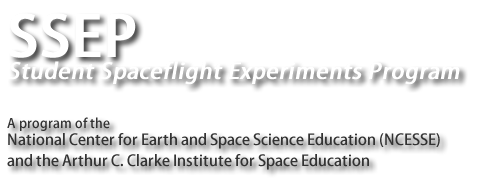NOTE: This is a sub-page of the About SSEP main page which you should read first.
The Flight Experiment Design Competition is designed to reflect how real science is done. Organizations like NASA and NSF routinely send out national Announcements of Opportunity (or AOs) to the professional science and engineering communities. These announcements might be opportunities for research funding, or opportunities to gain access to unique research resources, e.g., like a powerful telescope. All interested researchers must then submit a formal proposal, which they write to be consistent with proposal guidelines provided as part of the announcement. All the proposals from the research community are then submitted against a deadline, and a review board of peers is assembled to critically review proposals against assessment criteria that were part of the proposal guidelines. Each proposing team is competing head-to-head for limited resources, and the vast majority of the teams will loose. To be competitive, proposers need to be exceptional writers, capable of telling a coherent, concise, and powerful story about how their proposed research fits within the historical body of knowledge, and why it is important enough to win.
THE KEY POINT– real science is done by competition, and reflects an interdisciplinary weave of science, technology, history, and written communication skills—in the languages of both English (certainly in the U.S.) and MATHEMATICS. Competitions in education settings may seem to some like a gimmick for learning, are often not very substantial in required breadth and depth of content and inquiry, and are even viewed by some educators as an unhealthy learning style. But a core objective for the education of our children must be to prepare them for the real world. And high caliber STEM education is vital if we are to both inspire the next generation of scientists and engineers, and promote a scientifically literate public. We therefore firmly believe that high caliber science competitions ought to be formally integrated into the STEM curriculum as a means of providing real experience with real science. We cannot imagine a higher caliber STEM competition than students designing real experiments to fly in low Earth orbit in a professional mini-laboratory aboard the Space Shuttle or International Space Station.
Math … a language?! You might want to read this essay on cross-curricular math integration.
How the Competition Works
Your competition will result in multiple experiment proposals from student teams across your community. Each student team has a Teacher Facilitator, who serves as a liaison to the SSEP, and signs a Letter of Certification of a Student-Directed Effort which states that: 1) the experiment was designed by the students, but with possible input sought and received from professional researcher advisors, and 2) the proposal was written by the students with possible editorial input from the Teacher Facilitator. Each proposal is no more than 5 pages, and reflects a simple format defined in the SSEP Flight Experiment Proposal Guide, which also includes the proposal review criteria.
Your community will set up a Step 1 Review Board, which you can establish with local science educators and local area researchers (we can help you identify researchers in your area.) The task of the Step 1 Review Board is to review all proposals from across your community—based on the proposal review criteria in the Proposal Guide—and choose THREE finalist proposals for each experiment slot you have reserved. The community then forwards the finalist proposals to the SSEP for formal review by the SSEP National Step 2 Review Board—a national team of professional spaceflight scientists and engineers, and distinguished STEM educators—for flight experiment selection. The Step 2 Review Board will select one experiment to fly from your finalist proposals, for each experiment slot you have reserved. This 2-step proposal review process models a real call for proposals for a flight opportunity by NASA.
The approach described above serves to: 1) engage your community in the selection process, which in and of itself is a teachable moment for students and teachers, 2) limit to a manageable number the total number of proposals received for review by SSEP, and 3) allow the community to be of any size—given the community forwards only 3 finalist proposals to SSEP for each experiment slot the community has reserved.
Meet the remarkable SSEP National Step 2 Review Board for the STS-134 (Shuttle Endeavour) flight opportunity.
Review Criteria
The competition mirrors how professional scientists propose, conduct, and report on their research programs. It is a real world, multifaceted process that is far broader than just submitting an experimental write-up. It requires critical thinking in order to pose a good scientific question, and creatively design an experiment and experimental procedures that might provide an answer to the question. It requires a good understanding of the experimental constraints imposed by the flight opportunity. It requires an understanding of core knowledge—often across many disciplines —as the foundation for framing the experiment (teachers—read SSEP Director Jeff Goldstein’s essay The Power of Models for a powerful look at the process of scientific inquiry, knowledge versus process, and the immense power of models in science and science education.) And it involves important communication and writing skills to: justify the proposed experiment, put forward a competitive proposal, and ultimately report results to the larger scientific community.
The review criteria for proposals (contained in the Flight Experiment Proposal Guide) is therefore reflective of the entire process and the skill set each student team must bring to the opportunity. It is not simply about assessing whether a proposed experiment will pass a Flight Safety Review. This program is truly designed to let students BE scientists.
Read descriptions of the winning and finalist proposals for the STS-134 (Shuttle Endeavour) flight opportunity AND BE AMAZED.
FACT: For the STS-134 flight opportunity there were 447 student proposals submitted by student teams across the 16 participating communities, with 293 forwarded to Step 1 Review Boards.
Return to About SSEP main page?
